As video content continues to dominate the digital world, finding ways to create engaging and high-quality videos is a top priority for marketers and content creators. Producing videos quickly while keeping the audience entertained is essential to stay ahead. I came across an AI video generator…
Michael Dougherty, CEO & Co-Founder of Remix AI – Interview Series
Michael Dougherty, CEO & Co-Founder of Remix AI, a free-to-use app for exploring creativity with AI. The app allows users to create, share, and get inspired in a community full of artists and creative minds. Tell us about your journey in technology. I have always been…
Innovation in Synthetic Data Generation: Building Foundation Models for Specific Languages
Synthetic data, artificially generated to mimic real data, plays a crucial role in various applications, including machine learning, data analysis, testing, and privacy protection. In Natural Language Processing (NLP), synthetic data proves invaluable for enhancing training sets, particularly in low-resource languages, domains, and tasks, thereby enhancing…
How the brain responds to reward is linked to socioeconomic background
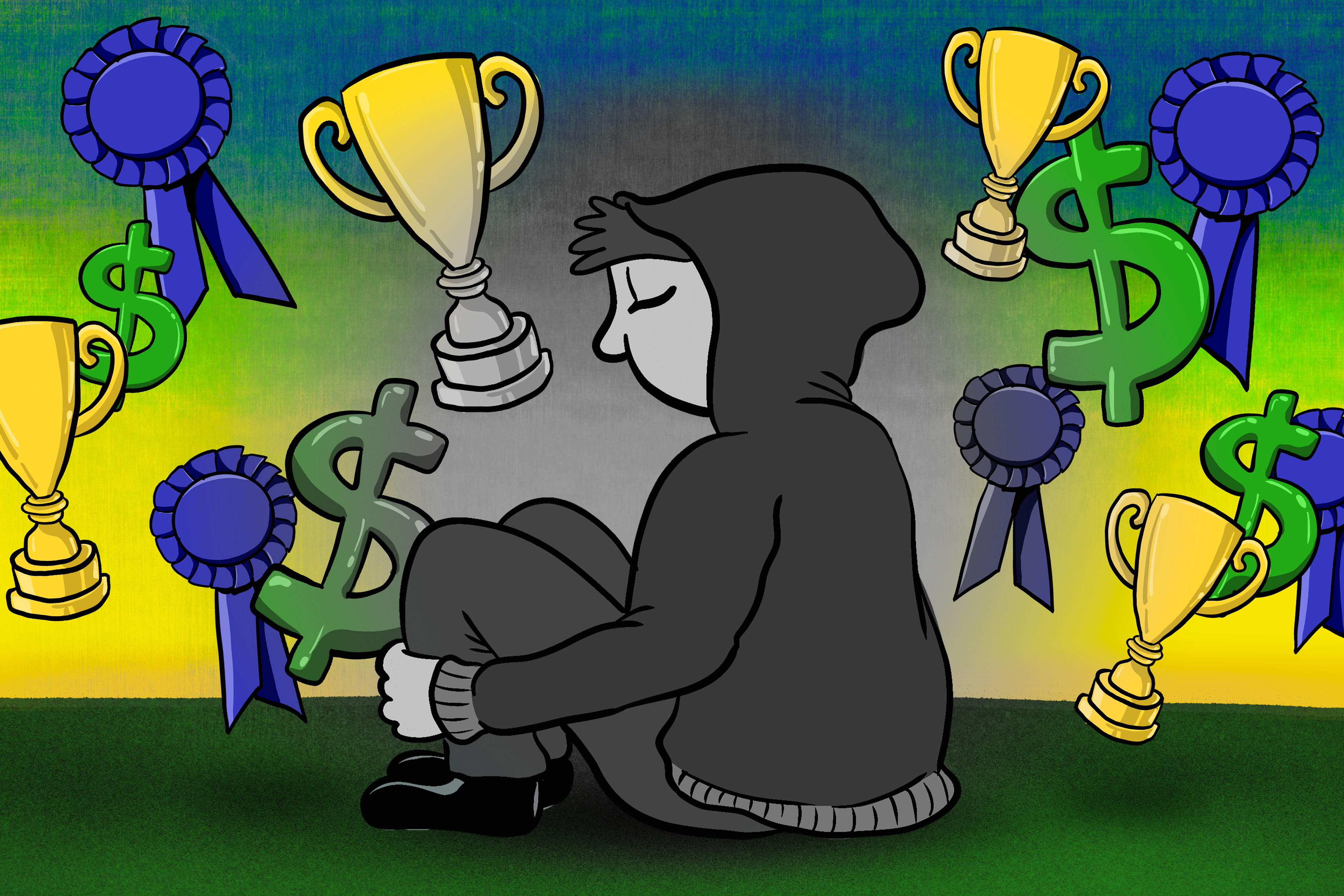
MIT neuroscientists have found that the brain’s sensitivity to rewarding experiences — a critical factor in motivation and attention — can be shaped by socioeconomic conditions.
In a study of 12 to 14-year-olds whose socioeconomic status (SES) varied widely, the researchers found that children from lower SES backgrounds showed less sensitivity to reward than those from more affluent backgrounds.
Using functional magnetic resonance imaging (fMRI), the research team measured brain activity as the children played a guessing game in which they earned extra money for each correct guess. When participants from higher SES backgrounds guessed correctly, a part of the brain called the striatum, which is linked to reward, lit up much more than in children from lower SES backgrounds.
The brain imaging results also coincided with behavioral differences in how participants from lower and higher SES backgrounds responded to correct guesses. The findings suggest that lower SES circumstances may prompt the brain to adapt to the environment by dampening its response to rewards, which are often scarcer in low SES environments.
“If you’re in a highly resourced environment, with many rewards available, your brain gets tuned in a certain way. If you’re in an environment in which rewards are more scarce, then your brain accommodates the environment in which you live. Instead of being overresponsive to rewards, it seems like these brains, on average, are less responsive, because probably their environment has been less consistent in the availability of rewards,” says John Gabrieli, the Grover Hermann Professor of Health Sciences and Technology, a professor of brain and cognitive sciences, and a member of MIT’s McGovern Institute for Brain Research.
Gabrieli and Rachel Romeo, a former MIT postdoc who is now an assistant professor in the Department of Human Development and Quantitative Methodology at the University of Maryland, are the senior authors of the study. MIT postdoc Alexandra Decker is the lead author of the paper, which appears today in the Journal of Neuroscience.
Reward response
Previous research has shown that children from lower SES backgrounds tend to perform worse on tests of attention and memory, and they are more likely to experience depression and anxiety. However, until now, few studies have looked at the possible association between SES and reward sensitivity.
In the new study, the researchers focused on a part of the brain called the striatum, which plays a significant role in reward response and decision-making. Studies in people and animal models have shown that this region becomes highly active during rewarding experiences.
To investigate potential links between reward sensitivity, the striatum, and socioeconomic status, the researchers recruited more than 100 adolescents from a range of SES backgrounds, as measured by household income and how much education their parents received.
Each of the participants underwent fMRI scanning while they played a guessing game. The participants were shown a series of numbers between 1 and 9, and before each trial, they were asked to guess whether the next number would be greater than or less than 5. They were told that for each correct guess, they would earn an extra dollar, and for each incorrect guess, they would lose 50 cents.
Unbeknownst to the participants, the game was set up to control whether the guess would be correct or incorrect. This allowed the researchers to ensure that each participant had a similar experience, which included periods of abundant rewards or few rewards. In the end, everyone ended up winning the same amount of money (in addition to a stipend that each participant received for participating in the study).
Previous work has shown that the brain appears to track the rate of rewards available. When rewards are abundant, people or animals tend to respond more quickly because they don’t want to miss out on the many available rewards. The researchers saw that in this study as well: When participants were in a period when most of their responses were correct, they tended to respond more quickly.
“If your brain is telling you there’s a really high chance that you’re going to receive a reward in this environment, it’s going to motivate you to collect rewards, because if you don’t act, you’re missing out on a lot of rewards,” Decker says.
Brain scans showed that the degree of activation in the striatum appeared to track fluctuations in the rate of rewards across time, which the researchers think could act as a motivational signal that there are many rewards to collect. The striatum lit up more during periods in which rewards were abundant and less during periods in which rewards were scarce. However, this effect was less pronounced in the children from lower SES backgrounds, suggesting their brains were less attuned to fluctuations in the rate of reward over time.
The researchers also found that during periods of scarce rewards, participants tended to take longer to respond after a correct guess, another phenomenon that has been shown before. It’s unknown exactly why this happens, but two possible explanations are that people are savoring their reward or that they are pausing to update the reward rate. However, once again, this effect was less pronounced in the children from lower SES backgrounds — that is, they did not pause as long after a correct guess during the scarce-reward periods.
“There was a reduced response to reward, which is really striking. It may be that if you’re from a lower SES environment, you’re not as hopeful that the next response will gain similar benefits, because you may have a less reliable environment for earning rewards,” Gabrieli says. “It just points out the power of the environment. In these adolescents, it’s shaping their psychological and brain response to reward opportunity.”
Environmental effects
The fMRI scans performed during the study also revealed that children from lower SES backgrounds showed less activation in the striatum when they guessed correctly, suggesting that their brains have a dampened response to reward.
The researchers hypothesize that these differences in reward sensitivity may have evolved over time, in response to the children’s environments.
“Socioeconomic status is associated with the degree to which you experience rewards over the course of your lifetime,” Decker says. “So, it’s possible that receiving a lot of rewards perhaps reinforces behaviors that make you receive more rewards, and somehow this tunes the brain to be more responsive to rewards. Whereas if you are in an environment where you receive fewer rewards, your brain might become, over time, less attuned to them.”
The study also points out the value of recruiting study subjects from a range of SES backgrounds, which takes more effort but yields important results, the researchers say.
“Historically, many studies have involved the easiest people to recruit, who tend to be people who come from advantaged environments. If we don’t make efforts to recruit diverse pools of participants, we almost always end up with children and adults who come from high-income, high-education environments,” Gabrieli says. “Until recently, we did not realize that principles of brain development vary in relation to the environment in which one grows up, and there was very little evidence about the influence of SES.”
The research was funded by the William and Flora Hewlett Foundation and a Natural Sciences and Engineering Research Council of Canada Postdoctoral Fellowship.
Get the Best Deals on YoloLiv YoloBox Ultra & Pro! – Videoguys

Gear up for a sensational spring with the latest YoloBox Ultra and Pro, your go-to solutions for seamless live productions. Dive into the extraordinary features of the YoloBox Ultra, including ISO recording, NDI support, and 4 HDMI inputs, all packed into a truly all-in-one system. Don’t miss the exclusive winter sale from 1/22 to 2/28/24, offering the YoloBox Ultra at just $1499 and the Pro at $999. Elevate your live production game with simplicity, portability, reliability, and affordability. It’s time to make your spring events unforgettable – grab your YoloBox now!
$1,499.00 SPECIAL Offer Expires 2/28/24 |
$999.00 SPECIAL Offer Expires 2/28/24 |
Explore YoloLiv’s Ultimate All-in-One Live Streaming Studios
|
YoloLiv Instream is the industry’s first vertical all-in-one encoder, switcher, monitor, and streamer. Create better content for Instagram, TikTok, and more. Add multi-cam, graphic overlays, picture-in-picture, chroma key, transition effects, lower thirds, countdown timer and more to elevate your vertical livestream to the next level. |
YoloBox Mini
YoloBox Mini is a super portable live streaming encoder, monitor, and recorder! As the name suggests, it’s very small compared to almost all other live streaming solutions. You can fit it in your pocket, especially perfect for live events that require high mobility. $699.00 |
|
YoloMax YoloMax makes Live Selling possible for all brands, retailers, and influencers. Unlock awareness, engagement, sales through shoppable livestream video. Stand Out, Sell Live.
$1,399.00 SPECIAL Offer Expires 2/28/24 |
VertiCam YoloLiv 12x Verticam PTZ Camera for Vertical Content. Vertical Video Made Easy. Industry’s First Vertical PTZ Camera For Vertical Content Creation & Live Streaming. $529.00 |
YoloBox “OG”
YoloLiv YoloBox is a Smart Multi-Camera Live Streaming Studio, Encoder, Switcher, Recorder, Monitor, All in One solution.The industry’s first REALLY All-IN-ONE live production system that doesn’t require anything external. It’s simple, portable, reliable and affordable. $699.00 |
What Is Palworld? The New ‘Pokémon With Guns’ Survival Game Everyone’s Playing
Palworld first captured the attention of gamers (and their internet sphere) when it was revealed back in 2021. While that reveal included details about the survival aspects of the game, including multiplayer, crafting, and farming, viewers honed in on the idea of it being Pokémon but with guns. You can capture Pokémon-like monsters called Pals in special balls (and you can capture humans, too), but it’s smart to shoot them or hack at them with an axe first to lower their health. And then, once under your command, you can give them their own guns to use, of course.
Following various trailers since that 2021 reveal, including this gameplay showcase and this one highlighting the different Pals you can find, we learned at Geoff Keighely’s Summer Game Fest last year that Palworld would finally enter Early Access on PC via Steam and on Xbox in January of 2024. Ahead of that launch, Game Informer spoke to developer Pocketpair about the game and internet speculation that it’s fake; and last week, we finally checked the game out for ourselves – watch Game Informer’s gameplay here. While we enjoyed playing the game’s first few hours, we never could have predicted how meteoric its first weekend would be.
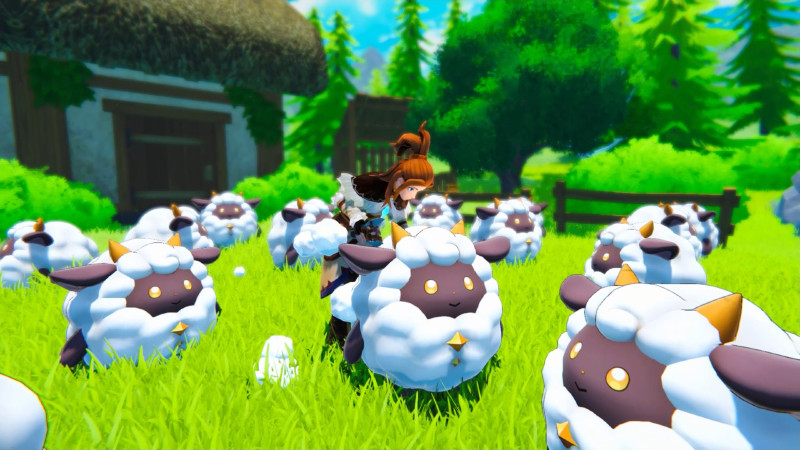
If you haven’t kept up, more than 5 million people purchased Palworld in its first 3 days on the market, with an all-time peak of 1,581,679 players playing it concurrently on Steam at the time of this writing (notably, this peak is different from the one I just saw moments ago, meaning even more players are continuing to pour in). That peak means Palworld has achieved the third-highest all-time peak in Steam history. It is safe to say Palworld is blowing past any and all expectations, and if you were on the internet at all this weekend, there’s a good chance you read about its debut, controversy, and more.
But if not, fear not – we’ve got you covered.
What Is Palworld?
[embedded content]
If you aren’t familiar , Palworld is a survival game from Pocketpair, an independent developer behind games like Craftopia and AI: Art Impostor (remember these names because they’ll come up again later); Pocketpair is based in Japan, ironically 10 minutes away from The Pokémon Company, as noted by VideoGamesChronicle’s Jordan Middler.
PocketPair, the company behind Palworld, is located about 10 minutes drive from The Pokemon Company. Junichi Masuda is going to deliver the cease and desist by hand. pic.twitter.com/IH6SNUae3G
— Jordan Middler (@JordanMiddler) January 19, 2024
While it’s easy to call the game “Pokémon with guns,” if you go in expecting that, you’ll likely be disappointed. While there are Pokémon-like creatures called Pals that look and behave like Nintendo’s famous pocket monsters, you aren’t a trainer traversing the world to collect gym badges and take on an Elite Four. You are someone attempting to survive a harsh environment with the help of Pals, guns, and various melee weapons.
You capture Pals similarly to how you might in a Pokémon game, utilizing a special ball to add them to your party and your Paldeck list. From there, you can use captured Pals to help you capture more or as workers in your home base factory, where they produce resources, automatically craft new things for your survival, and more. You can essentially enslave them, if you choose, although you don’t have to.
On PC, you can play with up to 31 other players on a single server; it only allows up to four total on Xbox. You can fight raid-like bosses together, build a base with friends, and encounter various NPCs in the world. In these ways and more, Palworld is more like Valheim than it is Pokémon, but it’s clear the “Pokémon with guns” pitch is what’s initially drawing players in.
Palworld’s Meteoric Launch
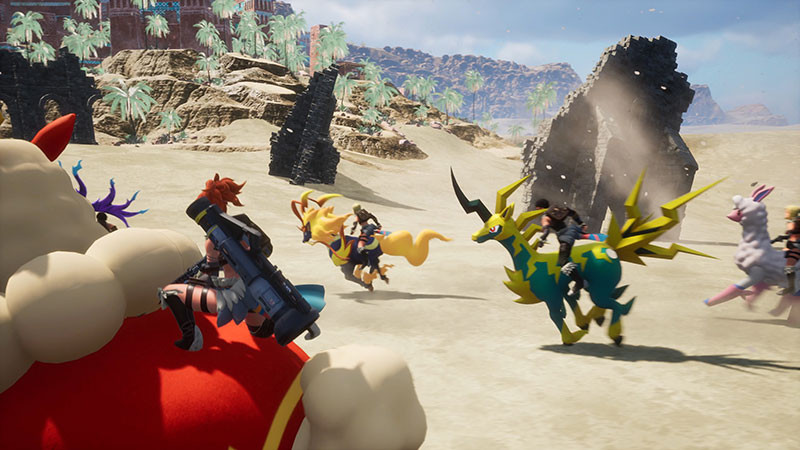
Palworld officially hit Early Access last week on Thursday, January 18. It quickly ranked third on Steam in its Top Wishlists, which often provides insight into how a game might sell. Within just eight hours of launching, Palworld crossed 1 million copies sold, according to the game’s official Twitter account. The Palworld servers were quickly over-encumbered by so many players, leading to issues for people trying to play the game.
“We are blown away with the response to Palworld and we’re doing our best to respond to your issues,” the Palworld Twitter account tweeted on January 19. “Currently, our server provider is reporting that due to the large amount of concurrent players, the servers have become unstable and you may be experiencing issues connecting to servers.”
Hello everyone,
We are blown away with the response to Palworld and we’re doing our best to respond to your issues!
Currently, our server provider is reporting that due to the large amount of concurrent players, the servers have become unstable and you may be experiencing…
— Palworld (@Palworld_EN) January 19, 2024
Palworld crossed 2 million copies sold in just 24 hours, on January 20, surpassing 730,000 concurrent players on Steam, achieving the 10th highest all-time peak in doing so. Palworld then hit another achievement just 16 hours later: 3 million copies sold in 40 hours. Server issues continued, but Pocketpair announced on January 20 it had an emergency meeting with Epic Games and its Epic Online Services team to resolve connectivity issues.
The hype surrounding Palworld continued through the weekend, selling 4 million copies in just three days. Pocketpair incorrectly announced on January 21 that Palworld achieved the highest concurrent player count of any paid game in the history of Steam, but internet sleuths were quick to point out that PUBG set this record in 2018 with 3.2 million players. In 2018, PUBG was a paid game – it went free-to-play in 2022, something Pocketpair says it was unaware of at the time of its post, which is why it thought it achieved said record.
Our apologies, we were unaware that PUBG previously obtained the record before becoming a f2p game.
Again, our apologies for this misunderstanding. https://t.co/r1YeN2Bed5
— Palworld (@Palworld_EN) January 22, 2024
On Monday, January 22, Pocketpair announced that Palworld has sold more than 5 million copies in three days. For reference, it took PlayStation 5-exclusive (and first-party developed) Marvel’s Spider-Man 2 11 days to hit the 5 million mark.
Today, Palworld sits in third place for all-time peaks in Steam history, behind PUBG’s 3.2 million peak and Counter-Strike 2’s 1.8 million concurrent player peak.
If one thing is clear, players were extremely interested in Palworld. However, it’s important to note it’s an Early Access game, which means Pocketpair presumably still has a lot of work to go into the game and that issues will likely be more abundant than a standard release. Only time will tell if these numbers hold, but right now, Palworld shows no signs of slowing down.
Palworld Controversy: A.I., Copyright, And More
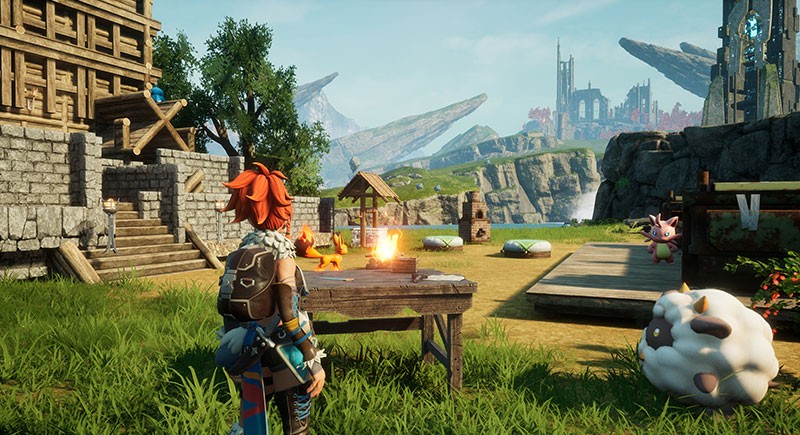
During Palworld’s massive launch, more and more players and spectators online began to throw some hefty accusations at Pocketpair. While the Pokémon comparison is clear, some have called into question both how Pals were created, claiming the use of A.I., and how similar some are to Game Freak’s own Pokémon designs.
Cecilia Fae on Twitter created a threat with dozens of Pals and the Pokémon they most resemble to give people an opportunity to see the similarities. Many seem extremely similar, leading to players and others calling into question copyright or blatant rip-offs of Pokémon, while others toe the line more than outright cross over it. Here are a few of the most similar in their thread:
I’ll start with the obvious ones and the further down I go the less obvious they’ll be, but things like concepts or colours might be derived. This one has ears and theme of leafeon and everything else of cinderace. The small hands, the fluff at the pants, all of it. pic.twitter.com/X3x8w7xvgq
— Cecilia Fae 🍂 (@CeciliaFae) January 21, 2024
There are many more examples in the full thread so be sure to check it out for additional information. But as you can probably see, some of these designs are questionable, leading to speculation that they’re straight-up model rips from Pokémon games.
This led internet sleuths back to Pocketpair’s 2020 survival game Craftopia. Around its 2020 release, Pocketpair was criticized for how similar to Nintendo’s 2017 release, The Legend of Zelda: Breath of the Wild, its latest game, Craftopia, was. With Palworld blowing up this weekend, people have looked back at Craftopia once more to point out its similarities to Breath of the Wild in light of Palworld’s similarities to Pokémon, and it’s, uhh, something – Craftopia definitely reminds me of Breath of the Wild in more ways than one.
Everyone’s talking about Palworld, but nobody is talking about their other game Craftopia
The first time I saw this trailer I was laughing for like ten minutes
Insanely blatant BotW clone footage being inter-spliced with the Cow Killer 9000 and Fortnite building pic.twitter.com/veIeAypHDj
— Drop everything and read Tomory (@JohnBGang) January 18, 2024
But I’m not a game developer – I don’t know the lines between “inspired” and “copycat.” Nintendo didn’t sue Pocketpair over Craftopia so I find it hard to believe the 2020 survival game did anything illegal. However, there is a line between, “Oh nice, you attempted to make your own original spin on Breath of the Wild,” and “Oh, you’re not even trying to hide how much you took from Breath of the Wild.” Where that line sits, I don’t exactly know, but the similarities are striking and worth discussing as players analyze Palworld and Pokémon.
Here’s another example of very similar Craftopia designs:
And here’s an additional example of someone pointing out similarities to Nintendo games within Pocketpair’s various releases:
I am the exact opposite of a Nintendo stan (or a Ark/Wildcard stan), but seeing Palworld make tens of millions of dollars off of the most blatantly creative bankrupt, poorly put together asset flip game is so depressing.
Their entire company strategy seems to be theft. pic.twitter.com/bRQxilrh94
— TeeHallums (@TeeHallums) January 20, 2024
The discussion of copyright, design similarities, and rip-offs continued throughout Palworld’s launch weekend – it’s still happening today at the time of this writing. While some cite model rips and uninspired design, others point to something potentially far more nefarious: A.I.
Before connecting A.I. accusations to Palworld, let’s talk about one of Pocketpair’s other games: AI: Art Impostor.
“AI: Art Impostor is an AI drawing party game for 3-8 players,” the Steam description for the game, which hit Early Access in November of 2022, reads. “You are a progressive artist who commands AI to generate images, and you don’t need aesthetic talent to draw good artwork.”

From the jump, AI: Art Impostor says it uses A.I. to generate images for the game, something sleuths found interesting in the wider debate of whether Pocketpair utilized A.I. in Palworld. Then, people discovered that Pocketpair’s CEO seems to be a supporter of generative A.I., a hotly-debated and controversial topic both in game development and throughout the tech world right now – read Game Informer’s feature about the game industry’s fight over A.I. here.
Heads up to anyone thinking of supporting/playing Palworld who also cares about genAI issues… The CEO of that studio is full speed ahead on generative AI, frequently promotes it and tries to push its use in his studio. Even made a game focused entirely around it using SD. pic.twitter.com/6fwvzhh6g7
— Invertex (@invert_x) January 19, 2024
Perhaps unsurprisingly, the internet has lost some nuance in this debate about Palworld, Pocketpair, and A.I., with many outright saying the game uses A.I. art. However, despite similarities to Pokémon – some think Pocketpair used generative A.I. art programs like Midjourney to feed it Pokémon designs and ask for something different – there’s no definitive proof to back up this claim.
VideoGamesChronicle translated a Japanese post made by Pocketpair’s CEO, Takuro Mizobe, addressing accusations toward the company. Curiously, Mizobe doesn’t directly address accusations of A.I. However, Mizobe says Pocketpair developers are receiving abusive comments and death threats.
“We are currently receiving abusive and defamatory comments against our artists, in addition to tweets that appear to be death threats,” Mizobe writes on Twitter, according to VideoGamesChronicle’s translation. “While we have received various opinions about Palworld, it is important to note that the supervision of all materials related to Palworld is conducted by a team, including myself. I bear the responsibility for the produced materials. I would appreciate it if these comments towards artists involved in Palworld would cease.”
As you can see, Mizobe doesn’t mention A.I. It remains unknown if the game uses it at the time of this writing, but Game Informer has reached out to Pocketpair for clarification and will update this story if it learns more.
[embedded content]
VideoGamesChronicle spoke to two experienced triple-A game artists about similarities between Pal designs and Pokémon. One artist told the publication, “You cannot, in any way, accidentally get the same proportions on multiple models from another game without ripping the models [or], at the very least, tracing them meticulously first.” That artist told VideoGamesChronicle they “would stand in court to testify as an expert on this.” They also point out that the silhouettes and proportions of Pals are “near-perfect matches” to certain Pokémon models, too.
Neither Nintendo, Game Freak, nor The Pokémon Company have commented on Palworld and its Pal design similarities to Pokémon. Given Nintendo’s legal track record, which includes winning a lawsuit against a ROM hacker that led to a 40-month prison sentence for the hacker, if the company feels it has a case, it will pursue that case in court. Only time will tell, though, if Nintendo will join the accusations of copyright and design plagiarism people on the internet have thrown at Palworld and Pocketpair.
However, it’s important to note that there are those who don’t believe Palworld to be as nefarious in design as others accuse it of being, at least without concrete proof yet, including Arkane Lyon co-creative director Dinga Bakaba, who directed 2021’s Deathloop and announced Marvel’s Blade on stage at The Game Awards 2023 back in December.
[embedded content]
In Bakaba’s Twitter thread, which begins with the tweet below, they explain the nuances of similarities in game design and development, different playstyles, parody, and more. It’s a great thread and well worth a read if you’ve been tracking Palworld all weekend:
Yeah, I’m surprised by how quickly this is escalating. I’ll try to organize my own hot take-ish thoughts in a thread, separating concept, execution, and dev. First: it’s not a Pokemon-like game. Digimon is. And even if it was, so what? (cries in FPS, BRs, Souls, hero shooters…) https://t.co/6jnWkfiANE
— Dinga Bakaba (@DBakaba) January 21, 2024
And to wrap up this deep dive into Palworld’s massive Early Access launch and the controversy and hype surrounding it, here’s what Palworld looks like with actual Pokémon in it (by way of a new PC mod):
For more about the game, head to Game Informer’s Palworld tag to watch trailers, gameplay, and read in-depth features.
What are your thoughts on Palworld? Let us know in the comments below!
Scientists Engineer Plant Microbiome for the First Time to Protect Crops Against Disease – Technology Org
Scientists have engineered the microbiome of plants for the first time, boosting the prevalence of ‘good’ bacteria that…
Gothic, Elex II Dev Piranha Bytes Addresses Studio Closure Rumors: ‘Don’t Write Us Off Yet’
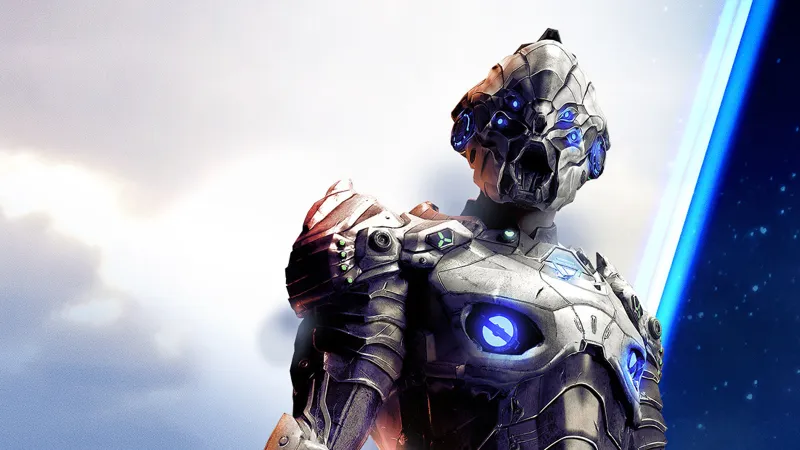
Last week, the internet began to speculate that Gothic and Elex II developer Piranha Bytes was being shut down after fans noticed the studio’s website was essentially defunct. Many speculated Piranha Bytes was another casualty in owner Embracer Group’s purge of studios that began last year after a planned $2 billion deal with Saudi Arabia-backed Savvy Games Group fell through in 2023.
[embedded content]
Studio closures at the hands of Embracer include Saints Row developer Volition Games and reformed TeamSplitters team Free Radical Design. Game Informer reached out to Piranha Bytes following last week’s speculation to see if it was, indeed, another closure at the hands of Embracer, and today, studio CEO Michael Rüve responded, stating the studio’s situation right now is difficult but that people shouldn’t write them off yet.
Here’s what Rüve’s statement says, in full:
“Dear fans, yes, it’s true. We, Piranha Bytes, are in a difficult situation. There are a lot of news about us circulating right now and this is our answer: Don’t write us off yet! We [will] do everything to continue creating worlds in which you can lose yourself. This is what our hearts have always beaten for. We are convinced that we will succeed. We are creative minds and there’s no lack of ideas! We stick together, no matter what.
“Now, we are focusing on this goal with all our strength and do whatever it takes to find a partner for this project. As soon as there [is] any news, we will share them with you. Thank you very much for your continuous support!”
This statement lines up with RPG Site’s reporting that Piranha Bytes is looking for a new publisher or buyer after Embracer decided to close the studio in November of last year. However, THQ Nordic, a publishing arm within Embracer, struck a deal with Embracer to give Piranha Bytes management more time to find a new publisher or buyer. This is likely the difficult situation Rüve’s statement is referring to, and the possibility of finding a new publisher or buyer is probably why he’s asking fans not to write the team off yet.
Only time will tell, but given the studio’s more than two decades of history in game development, and the human cost of studio’s closures and layoffs, here’s hoping the team finds a more stable owner or publisher.
2024 has already been marred by a heartbreaking string of layoffs, resulting in more than 3,000 jobs lost in the games industry and games-adjacent industry. And those job cuts come after a terrible 2023 where more than 10,000 developers and employees were laid off over the year.
Last week, Lords of the Fallen publisher CI Games laid off 10 percent of its staff. In this month alone, we learned Unity would be laying off 1,800 people by the end of March, and that Twitch was laying off 500 employees. Discord also announced it had laid off 170 employees. Game Informer covered layoffs happening at PTW, a support studio that’s worked with companies like Blizzard and Capcom, and at SteamWorld Build company, Thunderful Group, which let go of roughly 100 people, last week. Game Informer covered news about Dead by Daylight developer Behaviour Interactive reportedly laying off 45 people last week, too.
In January of last year, Microsoft laid off 10,000 employees amidst its ongoing $69 billion acquisition of Activision Blizzard, which it completed in October.
Striking Distance Studios, the team behind 2022’s The Callisto Protocol, laid off more than 30 employees in August of 2023. That same month, Mass Effect and Dragon Age developer BioWare laid off 50 employees, including long-time studio veterans. The following month, in September, Immortals of Aveum developer Ascendant Studios laid off roughly 45% of its staff, and Fortnite developer Epic Games laid off 830 employees.
In October of last year, The Last of Us developer Naughty Dog laid off at least 25 employees, and Telltale Games also underwent layoffs, although an actual number of affected employees has not yet been revealed. Dreams developer Media Molecule laid off 20 employees in late October.
In November, Amazon Games laid off 180 staff members, Ubisoft laid off more than 100 employees, Bungie laid off roughly 100 developers, and 505 Games’ parent company, Digital Bros, laid off 30% of its staff.
In December, Embracer Group closed its reformed TimeSplitters studio, Free Radical Design, and earlier in the year, Embracer closed Saints Row developer Volition Games, a studio with more than 30 years of development history. A few weeks before the winter holidays, Dungeons & Dragons and Magic: The Gathering owner Hasbro laid off 1,100 employees.
The games industry will surely feel the effects of such horrific layoffs for years to come. The hearts of the Game Informer staff are with everyone who’s been affected by layoffs or closures.
Apollo Justice: Ace Attorney Trilogy Review – Doing Ace Attorney Justice – Game Informer
Outsiders of the Ace Attorney series might not be familiar with the name Apollo Justice, but fans know the character is a big deal. He’s second only to Phoenix Wright in terms of playable appearances, and his new collection, the Apollo Justice: Ace Attorney Trilogy, gathers all of those outings in one convenient package. While there’s not much new content in this package, quality-of-life improvements and a visual overhaul do a lot to modernize Apollo’s courtroom saga, making it a worthwhile journey for fans new and old.
The package includes three games: Apollo Justice: Ace Attorney, Phoenix Wright: Ace Attorney – Dual Destinies, and Phoenix Wright: Ace Attorney – Spirit of Justice. While Apollo’s name is only in one of these three titles, he’s a crucial character in all three games, so the name is a fitting one. The package also includes DLC trials and outfits from the 3DS games, so if you want to rock Phoenix’s classic suit in Dual Destinies or dress Athena as a maid in Spirit of Justice, you’re free to do so. The DLC trials vary in quality (the second is great, the first is not), but they’re meaty pieces of content that I’m glad made it into the final collection.
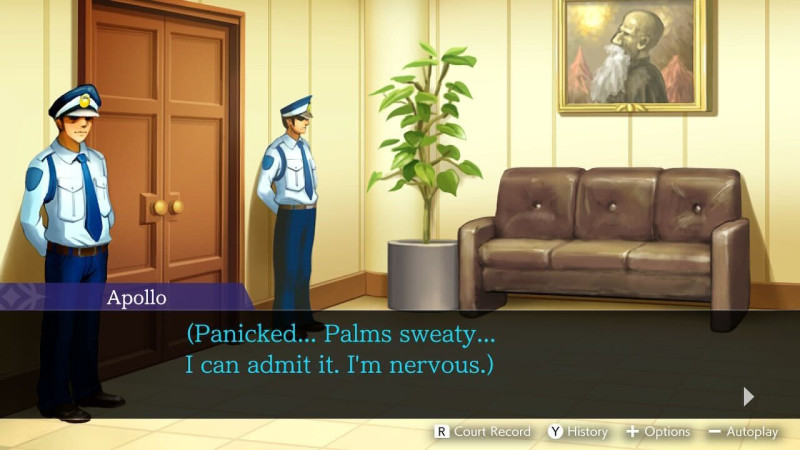
Apollo Justice prepares for his first trial in Apollo Justice: Ace Attorney
Besides the obvious convenience of being available on modern platforms, there are two main reasons to play the Apollo Justice Ace Attorney Trilogy instead of the original games. The first is the improved graphics; the Trilogy looks excellent. I’ll miss the pixel art of the DS days, but I quickly got used to the updated art style in Apollo Justice’s first outing. The animations translate exceptionally well – the series hasn’t lost an ounce of charm. The real improvement, however, comes in the latter two games in the Trilogy, which were originally released on the 3DS. While the first game is a good translation of the old art style into a new form, the 3D games look much better, and I often had to remind myself they weren’t released on the Switch from the get-go. It’s also great to view their anime cutscenes on a full-sized TV.
The other reason to play the Trilogy over old versions is its wonderful suite of quality-of-life improvements. I especially love Auto Advance, which moves the dialogue forward without forcing me to mash buttons, and the History button, which allows you to scroll back through dialogue you might’ve accidentally skipped. This game also includes a story setting, which automatically advances the game through trials and investigations if you don’t feel like solving any puzzles. While they’re mostly returning features from other modern Ace Attorney collections, the quality of life improvements return for a reason – they make these games significantly smoother to play, and I am extremely grateful to have them here.
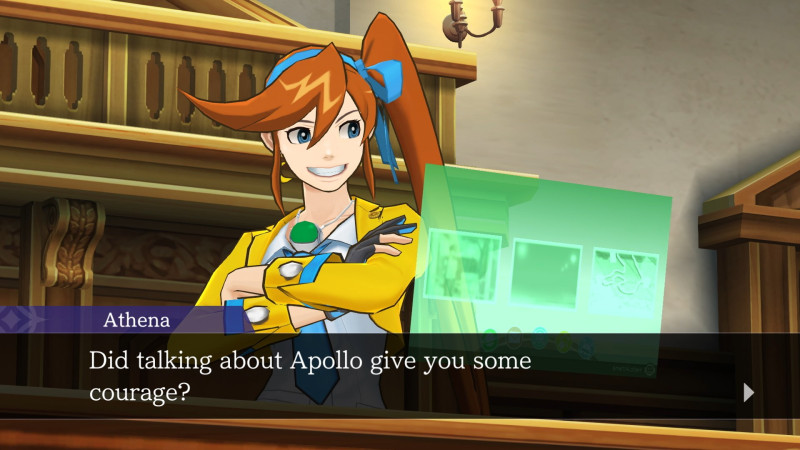
Athena Cykes in Phoenix Wright: Ace Attorney – Dual Destinies
Apollo Justice: Ace Attorney Trilogy also includes a Museum section that allows players to look at concept art, listen to music, rewatch cutscenes, and look at character animations from each game in the Trilogy. It’s a nice touch, and I had some fun glancing at some of the art and animations, but it’s more of a novelty than anything else.
Outside of quality-of-life improvements, the games are unchanged and still worth your time. Apollo Justice: Ace Attorney is a relatively faithful continuation of the original Trilogy that stars Apollo Justice, a plucky new protagonist. With 2D art and game direction by series creator Shu Takumi, it’s essentially an epilogue to the original Phoenix Wright games, giving players a glimpse into its world seven years after Ace Attorney 3. Today, its trials hold up as an exciting exploration of the failings of the court system and why it’s important to let a new generation take the reins.
Where Apollo Justice: Ace Attorney honors the older games, Dual Destinies seeks to forge a separate path with a new game director, three protagonists, and a new 3D art style. It’s the weakest game of the series, especially at the start, but the last few trials tie everything together with a genuinely satisfying conclusion. Its ambitions don’t always pay off, but now that a decade has passed, I can appreciate those ambitions more, especially how they paved the road for the next game.

Phoenix Wright in Phoenix Wright: Ace Attorney – Spirit of Justice
Spirit of Justice is the final game in the Trilogy and my favorite. It primarily occurs in the fictional country of Kura’in, where defense attorneys are sentenced to the same fates as those they defend. To complicate things even further, the royal family can conduct séances to play back the memories of the dead as evidence. The new location and heightened stakes do a lot to make this entry feel distinct from the others. In fact, Spirit of Justice is the first game in the Trilogy that doesn’t feel like it’s struggling to match the tone of the older games, fully setting itself apart by putting its trials in a new context. It’s not just the best in this collection; it’s one of my favorites in the entire series.
Apollo Justice: Ace Attorney Trilogy succeeds with everything it sets out to do, bringing three great games to modern consoles in their most approachable forms to date. I was fully immersed in its classic courtroom battles in the 80 or so hours it took me to get through all three titles. Even though not every trial is a winner, the majority are, and with a new suite of quality-of-life improvements, it’s never been easier or more enjoyable to experience Apollo Justice’s journey.
